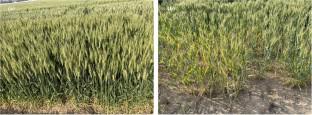Agronomy for Sustainable Development ( IF 7.3 ) Pub Date : 2022-04-14 , DOI: 10.1007/s13593-022-00766-8 Bing-Yang Liu 1 , Wen-Sheng Liu 1 , Bai-Jian Lin 1 , Wen-Xuan Liu 1 , Shou-Wei Han 1 , Xin Zhao 1 , Hai-Lin Zhang 1

|
Water shortage is a serious threat to agriculture production in the North China Plain. Sustainable management practices can improve the water use efficiency of winter wheat, but currently no academic consensus has been reached. Therefore, we performed a meta-analysis that included 2194 observations from 209 articles to assess the water use efficiency of wheat in this area. The groundwater provides for 34%–37% of wheat evapotranspiration, which increases the decline of groundwater levels. The management of wheat irrigation appears to be the key process in improving agricultural water use efficiency. We observed from regression analyses that the factors such as climate, soil, and management significantly affect the water use efficiency of wheat (p < 0.05). The data showed that nitrogen input and irrigation significantly increased wheat yields (p < 0.05), but irrigation did not significantly improve the water use efficiency compared to rain-fed wheat. The optimal water use efficiency was obtained when the irrigation amount was 80–160 mm, or irrigation was applied twice, or the seasonal irrigation amount plus precipitation was ≤ 240 mm. In contrast, a nitrogen input significantly increased evapotranspiration and water use efficiency. The water use efficiency improvement was especially prominent when the nitrogen application rate was 220–250 kg·ha−1. Moreover, subsoiling and straw return should be recommended for increasing yield, reducing evapotranspiration, and improving water use efficiency. These practices can ultimately save over 240 mm of water and 75 kg·ha−1 of nitrogen, which contributes to a sustainable agricultural development. Here, we demonstrate for the first time the impact of management practices on crop water use efficiency at a regional scale and propose a sustainable agricultural development scheme.
中文翻译:

提高华北平原冬小麦水分利用效率的可持续管理实践:荟萃分析
缺水是华北平原农业生产的严重威胁。可持续管理实践可以提高冬小麦的水分利用效率,但目前尚未达成学术共识。因此,我们进行了一项荟萃分析,包括来自 209 篇文章的 2194 条观察结果,以评估该地区小麦的水分利用效率。地下水提供了小麦蒸散量的 34%~37%,这加剧了地下水位的下降。小麦灌溉管理似乎是提高农业用水效率的关键过程。我们从回归分析中观察到,气候、土壤和管理等因素显着影响小麦的水分利用效率(p< 0.05)。数据显示,施氮和灌溉显着提高了小麦产量(p < 0.05),但与雨养小麦相比,灌溉并没有显着提高水分利用效率。灌水量为80~160 mm,或两次灌水,或季节性灌水量加降水≤240 mm时,水分利用效率最佳。相比之下,氮的输入显着增加了蒸发和水分利用效率。当施氮量为220~250 kg·ha -1时,水分利用效率的提高尤为显着。此外,应建议深松和秸秆还田,以提高产量、减少蒸散和提高水分利用效率。这些做法最终可以节省超过 240 毫米的水和 75 kg·ha -1的氮,这有助于农业的可持续发展。在这里,我们首次展示了管理实践对区域范围内作物用水效率的影响,并提出了可持续农业发展计划。



























 京公网安备 11010802027423号
京公网安备 11010802027423号